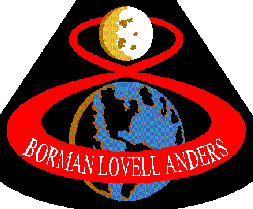www.moonlandings.co.uk
Apollo 1 | Apollo 7 | Apollo 8 | Apollo 9 | Apollo 10 | Apollo 11 | Apollo 12 | Apollo 13 | Apollo 14 | Apollo 15 | Apollo 16 | Apollo 17 | Apollo 18 - Soyuz | Saturn V | Launch Complexes | Apollo Mission Summaries | Apollo Facts | Luna | Costs
Apollo 8

Launched: 21 December 1968
Splashed Down: 27 December 1968
Crew:
Frank Borman
James A Lovell, Jr
William A Anders
For the first time in human existence, mankind finally broke the bounds of the Earth when the three Apollo 8 astronauts took humankind's first trip to the Moon. This flight was initially planned as another Earth orbiting checkout of the Apollo hardware, but rumours that the Soviets were plotting to beat the US into orbit around the Moon caused a little last-minute change in plans.
This was the first human spaceflight atop the Saturn V launch vehicle, which had flown only twice before. There could be no thought of a lunar landing; like Apollo, no Luner Module had been launched with them.
The booster worked flawlessly, as did the Service Propulsion Module. Who can forget Christmas Eve, when the astronauts passed behind the moon, and fired their engines while outside communications range? The whole nation, the whole world, sat and waited on the edge of our seats, waiting for the craft to come out from behind the Moon. Did the engines fire properly? Could they come home, or would they remain, forever trapped in the icy cold of space?
It all worked, and Apollo 8 proved at last that our horizons are truly limitless. Man had, at last, seen the Earth rise above the horizon of another world, and brought back the pictures to prove it!
Mission details:
Apollo-8 (24)
Pad 39-A (3)
Saturn-V AS-503 (3)
High Bay 1
MLP 1
Firing Room 1
Payload:
CSM-103
Mission Objective:
Demonstrate crew/space vehicle/mission support facilities during manned Saturn V/CSM mission. Demonstrate translunar injection, CSM navigation, communications and midcourse corrections. Assess CSM consumables and passive thermal control. Demonstrate CSM performance in cislunar and lunar orbit environment. Demonstrate communications and tracking at lunar distances. Return high-resolution photographs of proposed Apollo landing sites and locations of scientific interest. All mission objectives were achieved.
Launch:
21 December 1968, 07:51:00 EST. Kennedy Space Center Launch Complex 39-A.
Orbit:
Altitude: 190km x 180km
Orbits:
Duration: 6 Days, 3 hours, 0 min, 42 seconds
Landing:
27 December 1968; 10:52 EST; Landing point 8deg 7.5min North and 165deg 1.2min West. Miss distance was 2.5km; Splashdown time, 27 December 1968 at 10:52 EST; MET: 147:00:42. Crew on board USS Yorktown at 12:20 EST; Spacecraft aboard ship at 13:20
Mission Highlights:
Apogee, 190 kilometres; perigee 180 kilometres. Translunar injection at 02:56:05.5 MET; maximum distance from earth, 376,745 kilometres; lunar orbit insertion 69:08:20 MET; lunar orbit 312 km by 111 km; transearth injection, 89:19:17 MET.
In lunar orbit 20 hours, with 10 orbits. First manned lunar orbital mission. Support facilities tested. Photographs taken of Earth and Moon. Live TV broadcasts